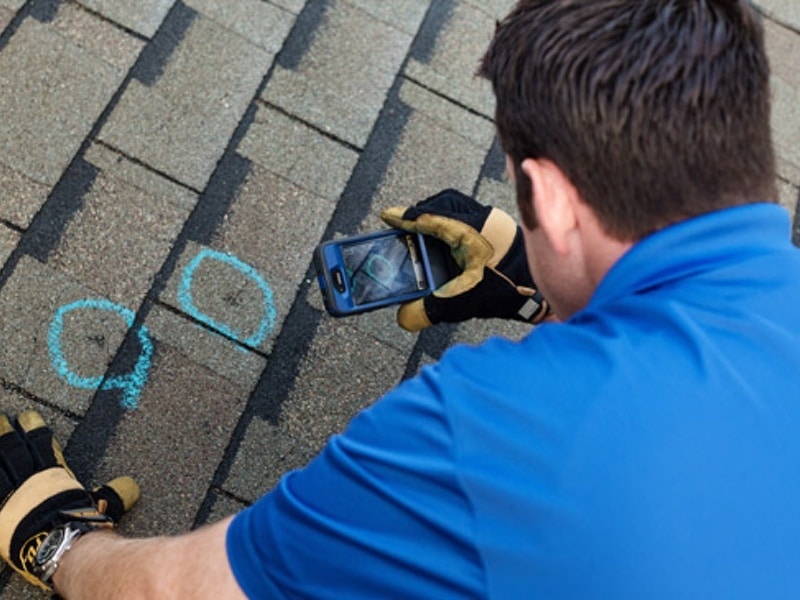 The most common complaint against home inspectors is missed roof leaks. Leaks can be unknown even to the home seller. A leaking roof can cause tremendous damage to the home and are costly to replace or repair. An inspector must use all his resources to determine the condition of the roof covering, and if it is keeping the water out. Consider that, on average, a roof can shed 30,000 gallons of rain water a year. By comparison that is 18,750 toilet flushes. That is a lot of water hitting the roof, passing through the gutters and finally hitting the ground. Roof style, height, pitch and covering materials are all important factors in determining the expected performance of the roof. The inspection standard requires that a description of how the roof was inspected is included in the report. Walking on the roof, if possible, is the best method to allow the inspector to closely examine the entire roof. However, due to height and roof pitch, walking on the roof is usually not an option. Using binoculars, viewing from the ground, looking out windows and putting a ladder to the eave edge are all acceptable alternatives. Any areas that are not view-able due to height or pitch must be identified in the report.
The most common complaint against home inspectors is missed roof leaks. Leaks can be unknown even to the home seller. A leaking roof can cause tremendous damage to the home and are costly to replace or repair. An inspector must use all his resources to determine the condition of the roof covering, and if it is keeping the water out. Consider that, on average, a roof can shed 30,000 gallons of rain water a year. By comparison that is 18,750 toilet flushes. That is a lot of water hitting the roof, passing through the gutters and finally hitting the ground. Roof style, height, pitch and covering materials are all important factors in determining the expected performance of the roof. The inspection standard requires that a description of how the roof was inspected is included in the report. Walking on the roof, if possible, is the best method to allow the inspector to closely examine the entire roof. However, due to height and roof pitch, walking on the roof is usually not an option. Using binoculars, viewing from the ground, looking out windows and putting a ladder to the eave edge are all acceptable alternatives. Any areas that are not view-able due to height or pitch must be identified in the report.
What’s The Condition of the Roof And Can It Keep Water Out?
Heat, wind, hail and water start to deteriorate shingles from day one and poor installation may not result in symptoms for years after the shingles are applied. An assessment on the roof’s condition requires many observations: Shingle wear and wear patterns, any patching, missing or broken shingles, ponding sediment on flat roofs, toe board holes, the number of roof covering layers and any sagging in the roof line. A roof inspection is not complete without an inspection of the underside of the roof which is performed via the attic. Any evidence of active or past leaking tied to shingle age is notable information. Elevated moisture levels in the roof sheathing in the attic may mean there is an active leak. During the inspection process all roofing on the house and any additional detached structures will be thoroughly inspected.
When Will the Roof Need To Be Replaced
This is difficult to answer as a roof that is working today could start leaking next week or in ten years. It’s possible for a new roof to leak and yet a 20-year old roof to still be going strong due to the unpredictable shingle life. A good standard might be that a typical three tab shingle has an average life of about 15 years. Typically, all bets are off after the next hail or wind storm.
Exterior and Interior Trouble Spots Are Inspected
Roof flashing, usually metal, is used at roof/wall junctures, around chimneys and above gutter terminations. Flashing is used at confluence areas to keep water from entering the structure. Kick out flashing is used above gutter terminations to “kick” water flow into a gutter or away from the siding. Flashings are inspected for condition, caulking and functionality. Skylights and attic vents are holes in the roof and provide possible water entry points. Properly installed components and flashing are essential for keeping water out. The exterior conditions are noted but more importantly, it is the interior that will show evidence of leaking or possible repairs.
Gutters and Downspouts To Be Inspected
Gutters and downspouts were previously discussed in the “Grounds” section as pertaining to water control, but a thorough inspection of the gutters and downspouts is imperative in the roof section of the inspection. Remember the aforementioned 30,000 gallons of water? A home’s gutters and downspouts have one job – which is to collect the water from the roof and direct it away from the house and foundation. Gutters must be free of debris and properly sloped to allow water flow. Gutters can sometimes pull away from their fastenings rendering them useless. Any missing gutters should be noted. Shingles, eave edge flashing or drip edge should lap over the back of the gutter so water does not get behind the gutter to the fascia and soffit. Though underground drains are a way of getting water away from the house without erosion or adding more surface water they are usually impossible to inspect. These problems should be noted in the inspection report with a suggestion that the customer check where the downspouts connect to the underground drains during heavy down pours.
Your Home Inspector serves as a Jack of all trades during the home inspection. He has to have the familiarity and knowledge to look for and ascertain the viability of not only your prospective home but all aspects of the property in question.
Home Inspector Series | View the rest of “A Home Inspectors Role” Series
Not all home inspectors are created equal. AA Home Inspection has sellers, homeowners, and realtors who use us time and time again, so they have the most accurate information possible before they buy or sell a property.
Contact us (859-448-0213 or 513-319-7770) -or- Request an Appointment To Get Started Today!
—
 About AA Home Inspection
About AA Home Inspection
AA Home Inspection is a locally owned and operated, full-time inspection company serving the Greater Cincinnati and Northern Kentucky area. We have the experience to provide high-quality results. When it’s time to buy a new home, you need to be able to turn to an experienced inspection company you can trust. AA Home Inspection employs a full-time staff of qualified inspectors and office staff. Since 2000 we have completed over 9000 inspections and you can be assured that your home inspection report will give you an in-depth look at your new property.
> Learn More

